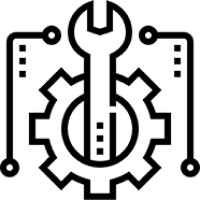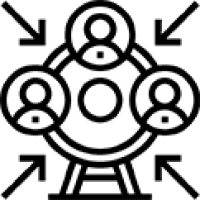EAC and Industrial Development & SMEs
The EAC Partner States aspire to transform their economies to a modern and industrialised status that can sustainably generate sufficient outputs to satisfy both domestic and export markets and rapidly increase per capita incomes to improve the living standards of their people. The industrial sector has the potential to contribute significantly to the economy by creating jobs, stimulating the development of other sectors like agriculture and services, increasing foreign exchange earnings, and modernising the lives of people. To address the challenges of industrial development, regional cooperation needs concerted efforts to create an effective policy coordination framework geared towards eliminating barriers to growth and enterprise upgrading at national and regional level. These efforts will also facilitate the identification of leverage elements that can be harnessed to accelerate the industrialisation process in each Partner State.
The German Government supports this EAC Sector under Core Area 1 of EAC-German cooperation as defined by BMZ 2030 – “Sustainable Economic Development, Training and Employment” in the Intervention Area of “Socially and Environmentally Sound Supply Chains, Trade and Sustainable Infrastructure”. The cooperation directly contributes to implement two of the eight priority areas defined by the 6th EAC Development Strategy, namely “Strengthening Productive and Social Sectors” and “Awareness Creation”. The BMZ 2030 reform strategy focuses on a new quality of cooperation. More information on BMZ 2030 can be found here.

Industrial Development & SMEs
EAC-Germany Support

SME Development
SMEs represent the biggest part of all registered entities in the majority of business sectors in the EAC region, averaging 60% in number, and even reaching 90% if micro-enterprises are also considered. Over the last decade, hundreds of thousands of micro-enterprises have flourished in East Africa in the areas of trade, services and industry as the region’s economies opened up. Only a few of these firms will grow into medium- and large-sized firms or expand to reach markets beyond their area of operations.
Projects:
SEAMPEC II (GIZ)
Objective: Integration of SMEs into regional and continental markets to enhance their business prospects and to effectively contribute to economic development in the EAC.
Approach: SEAMPEC II works closely with the Regional SME Platform and other actors on key EAC regional and AfCFTA-related issues supporting development of policy positions as well as capacity development through trainings and sensitization workshops. Additionally, the support is targeted towards strengthening the preparedness of SMEs in the AfCFTA processes.
Find more information on SEAMPEC II here.

Pharmaceuticals
The pharmaceutical manufacturers operating within the EAC region generally produce at a cost disadvantage to larger international generic product manufacturers due to a variety of reasons including scale, expensive asset bases coupled with older technology, higher financing costs plus a lack of integration with active pharmaceutical ingredients suppliers. Other challenges facing the local pharmaceutical production industry in East Africa include shortages of skilled professional personnel and unreliable supporting infrastructure such as electricity, water and transport. To change this, the EAC has prioritised the pharmaceutical sector in the EAC Regional Industrialisation Policy and Strategy (2012-2032) as well as the EAC Regional Pharmaceutical Manufacturing Plan of Action 2017-2027 and the EAC GMP Framework Roadmap. Since the COVID-pandemic, vaccine manufacturing is also high on the political agenda of the EAC. The EAC aims to reverse dependency on pharmaceutical imports from more than 70% currently to less than 50% by 2027 as well as establish state of the art vaccine manufacturing in the region.Projects:
SEAMPEC II (GIZ)
Objective: Strengthening value addition in the pharma sub-sector with a special focus on vaccine manufacturing.
Approach: SEAMPEC II supports the EAC Secretariat in implementing the EAC Regional Pharmaceutical Manufacturing Plan of Action 2017 -2027 and the EAC GMP Framework Roadmap with the goal of removing barriers to market access for pharmaceutical manufacturers and enhancing the supply of high-quality medicine in the region. The project works closely with the respective Technical Committees of the EAC Secretariat, the Regional Steering Committee, as well as the six National Coordination Committees and National Focal Persons. Additional key actors include the Federation of East African Pharmaceutical Manufacturers (FEAPM), national associations, national ministries, national medicines procurement agencies, regulators and pharmaceutical manufacturers.
SEAMPEC II offers technical support and guidance to strengthen institutional capacities of key actors. Additionally, the project facilitates and strengthens multi-sectoral stakeholder platforms, policy dialogue, consultative meetings at national and regional levels, capacity building and exchange programs, as well as in-depth studies and the development of policy documents. After supporting the overall pharmaceutical development of the EAC since 2009, the focus of SEAMPEC II has been widened to specifically include support to the international and EAC vaccine manufacturing initiative for Africa. SEAMPEC II cooperates with related programmes within German Development Cooperation and beyond to create positive synergies and maximise the project’s impact.
This part of SEAMPEC II is implemented by GFA Consulting Group GmbH Tanzania Branch.
Find more information on SEAMPEC II here.
QI Project (PTB)
Objective: Strengthen the Quality Infrastructure in the East African Community in line with the needs of the pharmaceutical sector
Approach: Regional manufacturers get better access to quality assurance services and capabilities of regulatory authorities to verify and certify products are improved. This includes:
- Joint training activities on specific good manufacturing practice aspects for private sector stakeholders and regulators
- Organisation of proficiency testing schemes to benchmark the quality of test results
- Support training course for maintenance of analytical equipment used in the pharmaceutical industry

Leather Agro-Processing
The leather sub-sector is strategic to the agro-processing/manufacturing priority of the EAC and constitutes more than 22% of intra-EAC trade. The industry faces many challenges, including poor production and processing practices, resulting in variable quality, high value leakage, environmental contamination, and low investment – all of this compounded by a weak enabling environment. The EAC is addressing those challenges through the newly developed EAC Strategy and Implementation Roadmap for Leather, Leather Products and Footwear. EAC-Germany is supporting the strategy implementation through multiple initiatives aimed at improving production skills and quality, export and cross-border trade. A focus lies on priority regional framework conditions for value addition to improve the sub-sector’s competitiveness. Beyond this, German companies have provided coaching and mentoring in production skills and new design ideas facilitated by EAC-Germany and are partnering with local companies to create top quality leather products together.Projects:
SEAMPEC II (GIZ)
Objective: Strengthening value addition in the leather sub-sector.
Approach: SEAMPEC II supports priority regional framework conditions for value addition to improve the leather industry’s competitiveness through:
• Supporting the implementation of the EAC Strategy and Implementation Roadmap for Leather and Leather Products (2019-2029). • Facilitating implementation of harmonised leather products standards, including Good Manufacturing Practices and Codes of Practices. • Assisting the implementation of harmonised trade facilitation processes (customs procedures). • Support to private sector value addition and trade initiatives in the sub-sector for deepening inclusivity and partnerships.
This part of SEAMPEC II is implemented by GFA Consulting Group GmbH Tanzania Branch.
Find more information on SEAMPEC II here.
QI Project (PTB)
Objective: Strengthen the Quality Infrastructure in the East African Community in line with the needs of the leather sector
Approach: The project develops capabilities and capacities to ensure that the quality infrastructure services along the leather value chain are upgraded and utilised. This includes:
- Organise benchmarking visits to other institutions and offer trainings on good manufacturing practices
- Develop self-assessment tool to weigh up the costs and benefits of implementing quality management systems for companies in the leather sector
- Purchase instruments for quality tests of leather according to international test procedures

Fruits and Vegetables Agro-Processing
The agricultural sub-sector of fruits and vegetables presents strategic opportunities for deepening regional cooperation. It offers the most direct employment of agro-manufacturing industries – employing more than 85% of rural households and providing high per unit resource productivity and returns. Furthermore, the sub-sector provides raw materials for processing industries and high product export value. It contributes more than 4% of intra-regional trade and 32% of EAC export trade, earning the region an average annual revenue of more than USD 134 million. Projections foresee a compound annual growth rate of 6% to reach some USD 1.3 billion in the next ten years. For those reasons, the F&V sub-sector is a priority in all EAC Partner States since it provides potential for addressing employment challenges especially among youth and women. However, the lack of vertical integration in the sector is quite significant in almost all Partner States due to the prevailing initial development process of industrialisation in the region. In addition, the sub-sector suffers from limited processing technologies for value addition. Preservation is often difficult as the raw material base is very expensive given the fragmented nature of small-scale producers. The packaging activities are underdeveloped, and the sector has not attracted significant investments. To tackle those challenges and utilise the opportunities offered by the sub-sector the EAC has developed and is now implementing the EAC Fruit & Vegetable Strategy and Action Plan as well as the EAC Post-Harvest Loss Management Strategy and Action Plan.Projects:
SEAMPEC II (GIZ)
Objective: Strengthening value addition in the fruits & vegetables sub-sector.
Approach: SEAMPEC II supports improved framework conditions through the implementation of the EAC Fruit & Vegetable Strategy and Action Plan (F&VSAP 2020-2030) as well as the EAC Post-Harvest Loss Management Strategy and Action Plan. These plans aim at:
• Better coordination and steering of the future development of the EAC F&V sub-sector. • Identifying and prioritising regional trade promotion in high value processed products through identifying gaps, training and implementation of select product standards and transparency measures. • Strategic training and implementation of harmonised customs procedures. • Implementation of priority policy measures to reduce post-harvest losses and create more value addition along the regional value chains. • Support to inclusive private sector networking and advocacy to promote trade integration for sustainable and equitable industrial development.
This part of SEAMPEC II is implemented by GFA Consulting Group GmbH Tanzania Branch.
Find more information on SEAMPEC II here.
QI Project (PTB)
Objective: Strengthen the Quality Infrastructure in the East African Community in line with the needs of the leather sector
Approach: The project develops capabilities and capacities to ensure that the quality infrastructure services along value chains in the fruits & vegetable sector are upgraded and utilised.
- Improve inhouse testing services for processors as well testing services of national food testing laboratories in order to guarantee conformity with regional and international standards
- Support and strengthen cooperation and exchanges between public (legal and regulatory) authorities and private-sector stakeholders